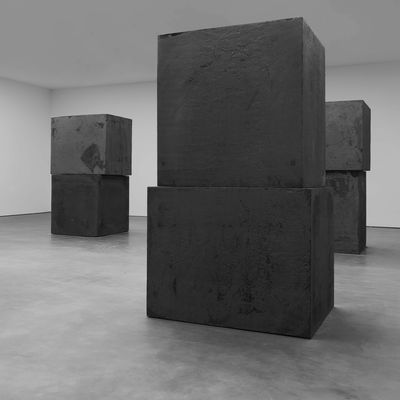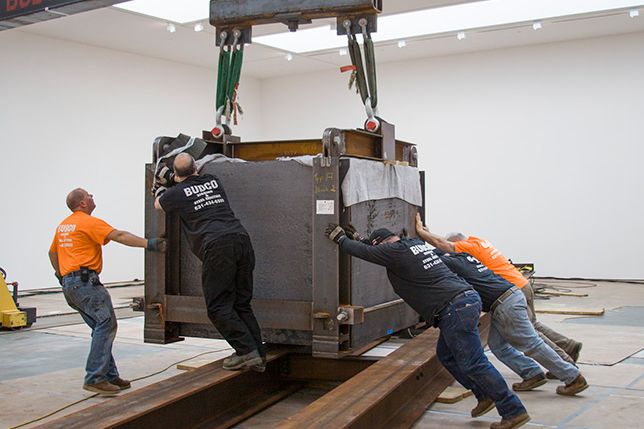
Art, at times, can resist being owned. Conceptual work is often immaterial. A Sol Lewitt painting exists as words rather than colors. And contemporary art’s tendency toward gigantism means that some sculptures are almost impossible to show in the already admittedly large homes of the average collector. Take Richard Serra, for example. The artist’s latest work, Equal, a series of paired 40-ton stacked steel cubes now on display at David Zwirner’s West 20th Street gallery, required master riggers, hydraulic gantries, and a custom runway just to be installed in a building itself expressly designed to accommodate artists’ big ideas.
Now, if you were to buy one, just imagine trying to get installing it by your co-op board.

“There’s no school you can go to to learn it,” said Joe Vilardi, vice-president of Budco Enterprises, the family business that has been installing Serra’s sculptures for over 25 years. Vilardi does have an official master rigger license from New York City, which requires “at least five years of practical experience in the hoisting and rigging business,” as well as “good moral character,” according to the city, but the art of installing a Serra is more about improvisation, what might be called site-specific work. “A lot of on-site experience really is what it comes down to,” he said.
For Equal, Vilardi had to get creative. “First, we had to get blocks into the space,” he said. “David Zwirner was concerned about the floor cracking.” The weight of the blocks could have shattered even the gallery’s cement foundation, so the team made a sculptural on-ramp. “Basically, we built a bridge from the street,” Vilardi said. “We actually applied the weight from those steel beams to the floor in only three spots where [the] structure below was reinforced and could take tremendous loads.”

Budco then landed the blocks on the runway with the help of a crane and slid them onto the bridge with rollers, pulled along by a winch. With the bottom blocks in place, the job became vertical. “We have a hydraulic gantry that we use quite often for Richard, it takes 400 tons,” Vilardi said. “Not that Richard has had a sculpture that weighs 400 tons, but it’s that extra capacity that makes things safe.” The team hooked onto the blocks using an external framework of steel beams, then hoisted them the five or six feet necessary to place one block on top of another by means of a gantry that’s also a trolley system.
Vilardi makes the process sound simple. It’s child’s play, after all, stacking cubes. But the structure of the gallery made things difficult. The door into the space had to be widened to fit even a single block through, a not-unexpected necessity. (“A lot of art doesn’t fit through the doors at galleries and museums. Walls and doors do come up and go down all the time,” he said.) Then, the ceiling only allowed six feet over the finished sculpture, requiring a rig as minimalist as the sculpture itself. “As Richard dreams new things up, we have to dream up new tools and equipment,” Vilardi said.

The blocks also had to be rotated so Serra could take advantage of the visual qualities of their varied sides, particularly those stacked on top, the placement of which subtly throw their bases off visual balance. “We spent weeks of engineering in our shop to figure out how to build a big swivel to have two or three guys make it rotate by hand,” Vilardi said. “We had to balance it on bottom and orient it perfectly.”
On a practical side, those looking to obtain a domestic Serra might want to consider downsizing from the 40-ton Equal pieces. Most buyers choose to install their Serras outdoors — but even that requires utmost care. You might want to hire Vilardi to put in a concrete foundation pad, for starters. You can’t just throw a Serra onto your lawn. Otherwise, depending on the quality of the soil, “it will sink and disappear,” Vilardi said. “What will happen with rain and freezing temperatures and thawing is that it’ll continue to sink and go off level and look ridiculous.”
But if a collector truly couldn’t live without a Serra as an indoor pet in her existing home? “I guess anything is possible. If you have a big enough space and if you wanted to open your floor and dig down eight feet and put in concrete, that could be done,” Vilardi said, laughing. “But in 25 years, I haven’t seen it done. Somebody will build a new room for them, a new private gallery. Typically they go outdoors.”

